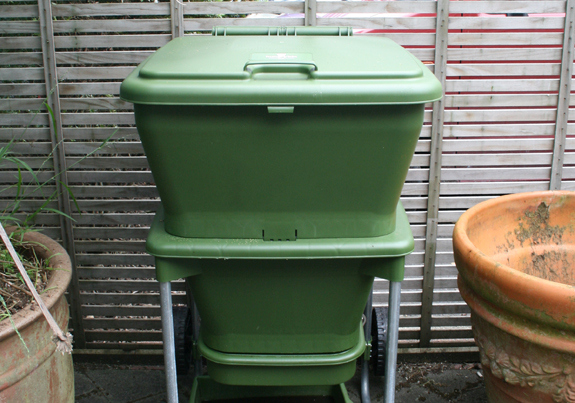Food waste makes nearly half of the rubbish we throw out of our homes –and a significant proportion of our workplace rubbish too. Have a look in the bin from your typicial Kiwi office and you’ll find a load of lunch scraps, banana skins and if there’s a coffee machine anywhere nearby, a small mountain of coffee grounds. The simple solution arrived a few months back in the form of a Hungry Bin…
Food waste makes nearly half of the rubbish we throw out of our homes –and a significant proportion of our workplace rubbish too. Have a look in the bin from your typicial Kiwi office and you’ll find a load of lunch scraps, banana skins and if there’s a coffee machine anywhere nearby, a small mountain of coffee grounds
Good is part of the Kiwi publishing company Tangible Media, and as a bunch of hard-bitten journos and adrenaline-junkie creative designer types we generate an impressive amount of coffee grinds in a week. The team at Good were keen to find a use for these grinds that was a bit smarter than just chucking them in the bin. Not to mention the banana skins, tea bags, shedded paper and a load of other rubbish that’s constantly being generated at our workplace.
Food waste makes nearly half of the rubbish we throw out of our homes – and a significant proportion of our workplace rubbish too. Have a look in the bin from your typicial Kiwi office and you’ll find a load of lunch scraps, banana skins and if there’s a coffee machine anywhere nearby, a small mountain of coffee grounds.
The simple solution arrived a few months back in the form of a Hungry Bin.
You don’t want bananas when you’re out fishing – Fishing World editor Andy Spear gets rid of his by giving them our hungry worms

Designed and made in New Zealand, Hungry Bins are a fast and convenient way to turn your food scraps into something useful. Not only can each Hungry Bin process up to two kilos of waste per day, they make fantastic fertiliser and plant food. They’re also innocuous looking (not unlike a big green wheelie bin) which is a bonus for the workplace.
How do they work? As the compost worms eat the waste in the bin, they convert it into worm castings. The castings are pushed down through the bin and compressed by the weight of fresh castings above them. The compressed castings sink to the lower part of the bin, where they can be easily removed when needed for use as plant food or soil conditioner. In normal operation, the castings will only need to be removed from the bin once every two to six months.
Liquid drains down through the bin and into the drip tray at the bottom. This liquid is an amazing concentrated fertiliser. It is best to dilute the liquid with water by a ratio of about 1 to 10 before feeding it to plants, as it’s very concentrated.
The liquid that drains out of the bin is an amazing concentrated fertiliser

So far the worm juice has just been used to feed our company’s houseplants. But the next project we have planned is a mesclun salad garden for our workplace courtyard, for fresh lunchtime greens.
Who says we can’t enjoy a bit of the good life at work!
For more, go to www.hungrybin.co.nz.
And to be in to win a hungry bin of your own, check out the latest issue of Good.







